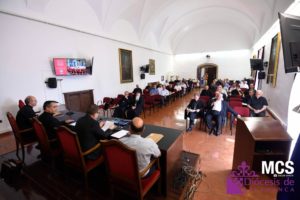Chronicle of the XLVI Conference of the Spanish Association of Liturgy Teachers, with the theme The essence of the Roman Rite
RAMÓN NAVARRO GÓMEZ (Episcopal Delegate for Liturgy)
In the wonderful setting of the Colegio Arzobispo Fonseca, in the city of Salamanca, the XLVI Conference of the Spanish Association of Liturgy Teachers, with the theme The essence of the Roman Rite, on Tuesday, August 23.
At 11:30 a.m., the opening of the conference, with the words of the president of the association, D. Jaume González, in which he justified the theme of the conference, given the different ecclesial and liturgical situations, thanking the availability of the different speakers and detailing the program of the same , around the affirmation about the essentiality of the Roman rite collected in Sacrosanctum Concilium 38.
He stressed the importance of ritual. He also recalled that these days the elections for the board renewal of the AEPL, and the minutes of the last sessions in Santiago de Compostela would be delivered. The absent and recently deceased members of the association were also remembered.
First presentation
The first presentation was given by Father Juan Javier Flores, OSB. He began by talking about the origins of roman ritein that attempt to find what is essential, what endures, the substance, in the context of the possible adaptations of the rite and its inculturation, which was discussed both in the pre-Council and in the Council itself.
In any case, once approved Sacrosanctum Concilium, Fr. Flores noted the difficulty of defining that substantiality, although with the consensus of the reference point of the typical editions. He referred to the well-known work by E. Bishop entitled The Genius of the Roman Riteand noted the features: simplicity, practicality, sobriety, discipline.
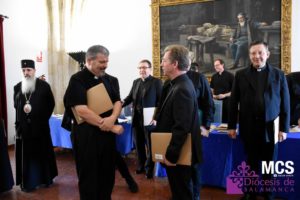 In the afternoon, at 4:00 p.m., we were able to attend the presentation of the apostolic exarch of Greece, Bishop Manel Nin OSB,with the title What is a rite, according to the Eastern vision? To answer that question, he started from canon 28.1 of the Code of Canon Law of the Eastern Churches. Then he developed the paper based on the liturgical, theological, spiritual and disciplinary aspects. He showed how the rite, especially in the East, is a sign of belonging to and manifestation of a Church, as well as of his profession of faith.
In the afternoon, at 4:00 p.m., we were able to attend the presentation of the apostolic exarch of Greece, Bishop Manel Nin OSB,with the title What is a rite, according to the Eastern vision? To answer that question, he started from canon 28.1 of the Code of Canon Law of the Eastern Churches. Then he developed the paper based on the liturgical, theological, spiritual and disciplinary aspects. He showed how the rite, especially in the East, is a sign of belonging to and manifestation of a Church, as well as of his profession of faith.
various communications
After a break, at half past five the communications framed within the work seminars began: the liturgical space (P. Ignasi Fossas, OSB). In his exhibition he started above all from the work Architecture and Liturgyby L. Bouyer, trying to find the architectural testimonies of the Roman rite in its most genuine expression.
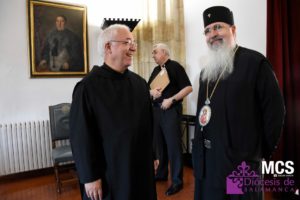 canon issues (D. Juan Damián Gandía). Starting from the right of application of the “motu proprio” magnum principiumdistinguished between confirmation Y recognitionby the Dicastery for Divine Worship and the Discipline of the Sacraments, from the texts prepared by the Episcopal Conferences.
canon issues (D. Juan Damián Gandía). Starting from the right of application of the “motu proprio” magnum principiumdistinguished between confirmation Y recognitionby the Dicastery for Divine Worship and the Discipline of the Sacraments, from the texts prepared by the Episcopal Conferences.
inculturation (Fr. Gabriel Seguí, MSSCC). He raised the concept, from Varietates Leginimae and of Redemptoris Missiothen making a historical journey with several examples, thus arriving at a series of principles, highlighting that the inculturation of the liturgy is not the first step in the inculturation of the faith.
The Eucharist, presided over by the Father Juan Javier Flores, OSBwith the assistance of SER Mons. Manel Nin, was celebrated at the New Cathedral of Salamanca. At the end of it, we had the opportunity to visit the Old Cathedral and the Cloister, thus concluding the work of the day.
Lauds prayer in La Purisima
Wednesday, August 24, began with the prayer of lauds in the magnificent church of La Purisima, presided over by D. Elisardo Temperán, member of the association. At the same time, we learned of the news of the death of Fr. Juan María Canals, a member of the association since its inception, and for so many years, director of the secretariat of the Episcopal Commission for the Liturgy. Rest in peace.
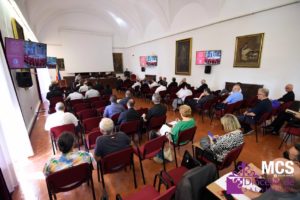 Already involved in the work of the day, we begin with the only presentation scheduled for that day, in charge of, Mr. Juan Miguel Ferrer Greneschedoctor in liturgy, professor at the IST “San Ildefonso”, Toledo, with the title, The substance of the Roman rite. Specific characteristics. In his presentation, D. Juan Miguel starts from the presentation made the day before by Fr. Juan Javier himself, from number 38 of SC.
Already involved in the work of the day, we begin with the only presentation scheduled for that day, in charge of, Mr. Juan Miguel Ferrer Greneschedoctor in liturgy, professor at the IST “San Ildefonso”, Toledo, with the title, The substance of the Roman rite. Specific characteristics. In his presentation, D. Juan Miguel starts from the presentation made the day before by Fr. Juan Javier himself, from number 38 of SC.
His reflection aims to focus on the concrete: to portray the Roman rite through key strokes in his stable and identity traits, beyond adaptations or historical eventualities. As a premise, it was based on a brief historical evolution of the Roman rite, from the beginning to the Second Vatican Council, paying special attention to the adaptations of the rite.
Eastern and Western liturgies
From there, and in comparison with the other liturgies of the East and the West, an attempt is made to see what those substantial or identity features are. The reference would be first liturgical books and the “classical Roman liturgy”. Some features of it stand out that would be an example of that essentiality: the cycle of the Liturgical Year; the option for short biblical readings in number and length; structuring according to the Alexandrian model of the Eucharist Prayer and theological-discursive style of the same prayer; opening of the variability in the celebration.
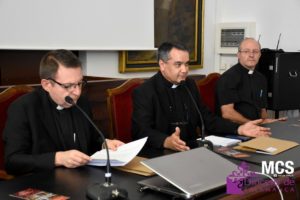 After a short break, around twelve o’clock, the second part of the seminars began, with the dialogue among those who had signed up for each one.
After a short break, around twelve o’clock, the second part of the seminars began, with the dialogue among those who had signed up for each one.
In the afternoon, starting at four, the ordinary assembly of the AEPL, where the theme, place and dates of the next Conference are chosen, which will be held in Valencia, D. m., the last week of August 2023, with the title: “Paschal Triduum. From memorial to mimesis”.
Within the same assembly, the new board is elected, once the triennium has concluded since the election of the current members. As the new president, elected but pending confirmation by the EEC, he is elected, the Father Juan Javier Flores Arcasand the rest of the board is re-elected.
Eucharist in San Esteban
The Eucharist is celebrated in the convent of San Esteban de los PP. Dominicans, after a very interesting visit of the place. presides over Rev. Josep Maria Soler, OSB, Abbot Emeritus of Montserrat. The day ends with a dinner in the gardens of the Casa de la Iglesia and a night visit to the towers of the cathedral.
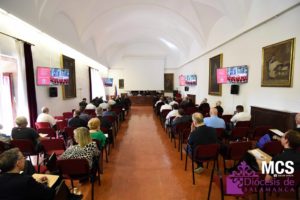 The last day of the Conference, Thursday 25, begins again with the prayer of Lauds in the Church of La Purisima, presided over by, Mr Joan Obach, member of the board of the AEPL.
The last day of the Conference, Thursday 25, begins again with the prayer of Lauds in the Church of La Purisima, presided over by, Mr Joan Obach, member of the board of the AEPL.
At ten o’clock in the morning the last of the presentations takes place, by the Rev. Father Josep Maria Soler i Canals, abbot emeritus of Montserrat and professor of the philosophical and theological school of said abbey. The theme is: A spirituality typical of the Roman rite? Entering the subject, Fr. Soler begins by exposing the difficulty of the argument.
Communion with God Trinity
Part of his exposition of the explanation of what spirituality is in general and its necessity today for the human being. Already entering the sphere of Christian spirituality, he posits as an ideal communion with God the Trinity, the object of eternal happiness, which later translates into attitudes, actions and accents, especially around the theme of prayer, personal and community. He then goes on to speak of liturgical spirituality proper, stating that liturgy and spirituality are connatural realities: the liturgy is the primary source of our spiritual life.
 He points out the importance of meditation on the texts and of thanksgiving, and the importance of unity among word and sacrament. He points out four dimensions: universality, objectivity, dialogue and communion; as well as five properties: Christocentric and Easter, biblical, sacramental, ecclesial and cyclical. Finally, he talks about the adaptation of rites and rubrics within the established limits.
He points out the importance of meditation on the texts and of thanksgiving, and the importance of unity among word and sacrament. He points out four dimensions: universality, objectivity, dialogue and communion; as well as five properties: Christocentric and Easter, biblical, sacramental, ecclesial and cyclical. Finally, he talks about the adaptation of rites and rubrics within the established limits.
After a break, information is given from various academic centers -Institute ad instar facultatis of Barcelona and the Pontifical University of the Holy Cross of Rome-, as well as the secretariat of the Episcopal Commission for the Liturgy.
The sessions are closed by the outgoing president, Mr. Jaume Gonzalezand also intervenes briefly, Mr. Juan Javier Flores, elected new president, in the absence of confirmation by the Spanish Episcopal Conference. The Eucharist, presided over by D. Jaume González, in the church of La Purísima, culminates the work of these days.

